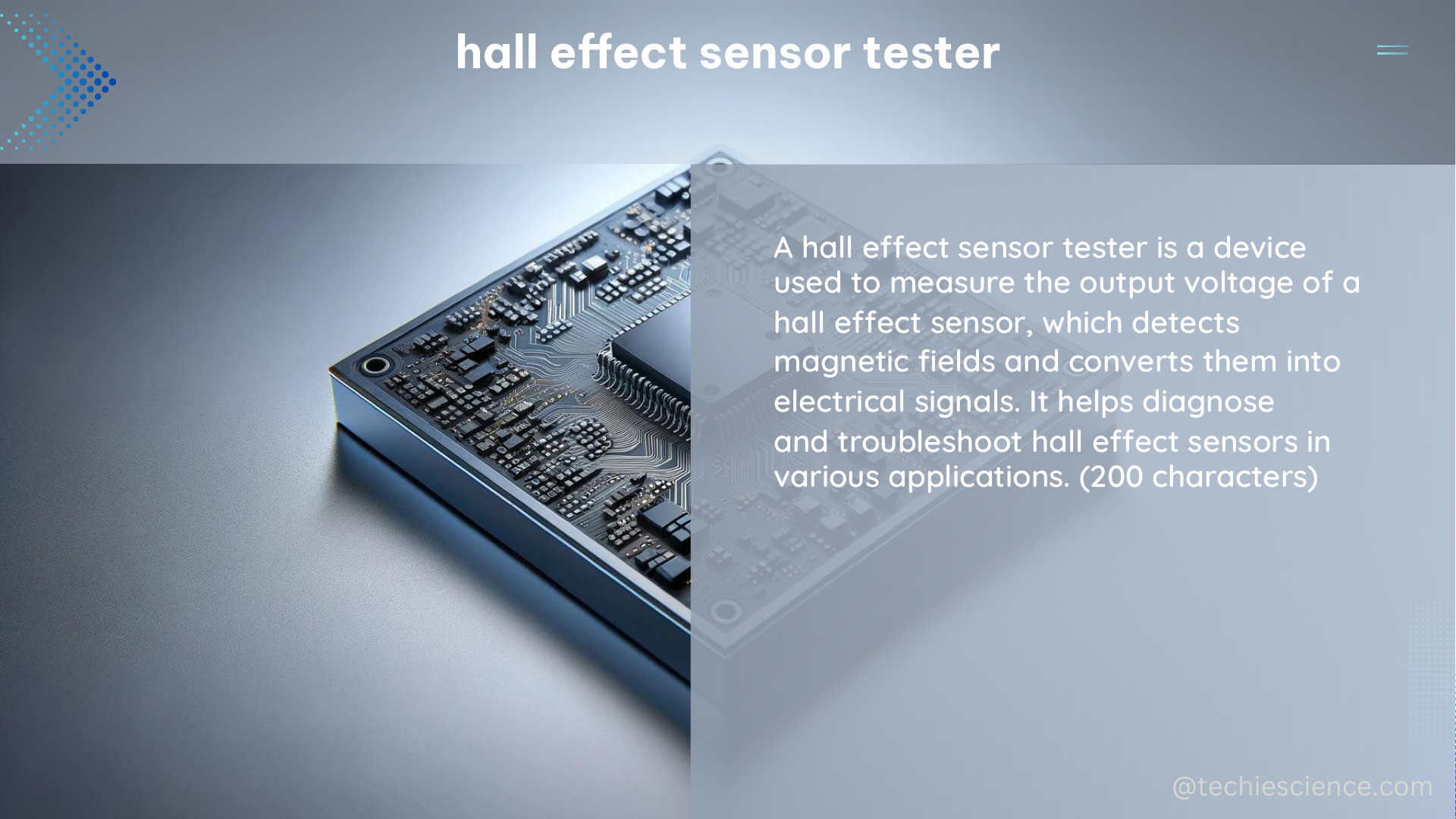A Hall Effect Sensor Tester is a versatile device used to evaluate the functionality and performance of Hall Effect Sensors, which are widely employed in various industries, including automotive, industrial, and aerospace applications. These sensors play a crucial role in measuring magnetic fields and converting them into electrical signals, making them essential components in numerous systems and devices.
Technical Specifications of a Hall Effect Sensor Tester
-
Output Voltage Range: The output voltage range of a Hall Effect Sensor Tester typically spans from 0 to 5 volts, allowing for the simulation of diverse magnetic field strengths. This adjustable range enables comprehensive testing and evaluation of the sensor’s response to varying magnetic conditions.
-
Current Consumption: The current consumption of the tester is a crucial factor, as it directly impacts the overall power consumption of the system. A typical Hall Effect Sensor Tester has a current consumption of less than 50 milliamps, ensuring efficient and reliable operation.
-
Response Time: The response time of the tester, which is the time it takes to detect a change in the magnetic field and output a corresponding electrical signal, is typically less than 1 millisecond. This rapid response time is essential for applications that require real-time monitoring and control.
-
Accuracy: The accuracy of the tester is a critical parameter that determines the reliability of the test results. The accuracy of a Hall Effect Sensor Tester is typically within ±1% of the full-scale output, ensuring precise and reliable measurements.
-
Temperature Range: The temperature range over which the tester can operate reliably is typically between -40 and +85 degrees Celsius. This wide temperature range allows for testing and evaluation of the sensor’s performance under diverse environmental conditions.
-
Operating Frequency: The operating frequency of the tester, which is the frequency range over which it can detect changes in the magnetic field, is typically up to 10 kHz. This high-frequency capability enables the tester to assess the sensor’s performance in applications that require rapid magnetic field monitoring.
Designing a Hall Effect Sensor Tester

In addition to the technical specifications, the design and integration of a Hall Effect Sensor Tester into the development process can significantly contribute to obtaining a robust and reliable system. One effective approach is the use of Design of Experiments (DOE), a statistical method that can be employed to optimize the test parameters and find a design that is well-suited for a wide range of operating conditions.
By leveraging DOE, engineers can systematically explore the relationships between various input factors (such as magnetic field strength, temperature, and frequency) and the tester’s performance metrics (such as output voltage, accuracy, and response time). This approach allows for the identification of the most influential factors and the optimization of the tester’s design to ensure consistent and reliable performance across a wide range of operating scenarios.
Building a Hall Effect Sensor Tester DIY
For those interested in constructing a Hall Effect Sensor Tester DIY, the following steps can be followed:
-
Gather the Components: The essential components required to build a Hall Effect Sensor Tester DIY include a Hall Effect Sensor, a voltage regulator, a current limiting resistor, a potentiometer, and a breadboard.
-
Assemble the Circuit: The circuit can be assembled on a breadboard by connecting the Hall Effect Sensor to the voltage regulator and current limiting resistor. The potentiometer can be used to adjust the output voltage, allowing for the simulation of different magnetic field strengths.
-
Test the Circuit: To test the circuit, apply a magnetic field to the Hall Effect Sensor and measure the output voltage. The output voltage should increase or decrease in response to the changes in the magnetic field, indicating the proper functioning of the sensor.
-
Calibrate the Tester: The tester can be calibrated by adjusting the potentiometer to obtain the desired output voltage range, ensuring accurate and reliable measurements.
By following these steps, you can create a customized Hall Effect Sensor Tester that meets your specific testing requirements and provides valuable insights into the performance of your Hall Effect Sensors.
Conclusion
The Hall Effect Sensor Tester is a crucial tool for ensuring the reliable and accurate performance of Hall Effect Sensors in a wide range of applications. By understanding the technical specifications, design considerations, and DIY construction process, you can develop a comprehensive testing solution that supports the development and deployment of robust and efficient systems.
References
- Advanced Research Directions on AI for Science, Energy, and Security
- DoD Reliability Availability and Maintainability (RAM) Guide
- Check and change ABS sensor
- Measurement-based Quality Assessment of Requirements
- Getting Acquisition Right – DoD

The lambdageeks.com Core SME Team is a group of experienced subject matter experts from diverse scientific and technical fields including Physics, Chemistry, Technology,Electronics & Electrical Engineering, Automotive, Mechanical Engineering. Our team collaborates to create high-quality, well-researched articles on a wide range of science and technology topics for the lambdageeks.com website.
All Our Senior SME are having more than 7 Years of experience in the respective fields . They are either Working Industry Professionals or assocaited With different Universities. Refer Our Authors Page to get to know About our Core SMEs.